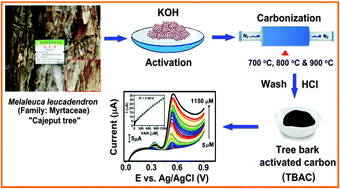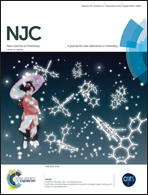Cajeput tree bark derived activated carbon for the practical electrochemical detection of vanillin
Abstract
Cajeput tree bark derived activated carbon (TBAC) has been prepared and exploited for the electrochemical detection of vanillin (VAN). The physicochemical properties of the TBACs graphitized at different temperatures were characterized using a variety of analytical and spectroscopic techniques, which include X-ray diffraction, field emission-scanning/transmission electron microscopy (FE-SEM/TEM), N2 adsorption/desorption isotherm measurements, and thermogravimetric analysis (TGA). Utilized as VAN sensors, the electrochemical activities of various TBAC modified electrodes were assessed using cyclic voltammetry (CV) and linear sweep voltammetry (LSV). The observed superior electrocatalytic activity for the oxidation of VAN is attributed to the high surface area and desirable porosities possessed by TBAC. The VAN sensor exhibited a wide linear range (5–1150 μM), low detection limit (0.68 μM), and excellent sensitivity (0.32 μA mM−1 cm−2), which surpass the existing carbon-based electrodes reported in the literature. The facile VAN sensor subsequently realized is also advantaged by its simplicity, stability, reliability, durability, and low cost, which render real sample analysis and practical industrial applications.



 Please wait while we load your content...
Please wait while we load your content...